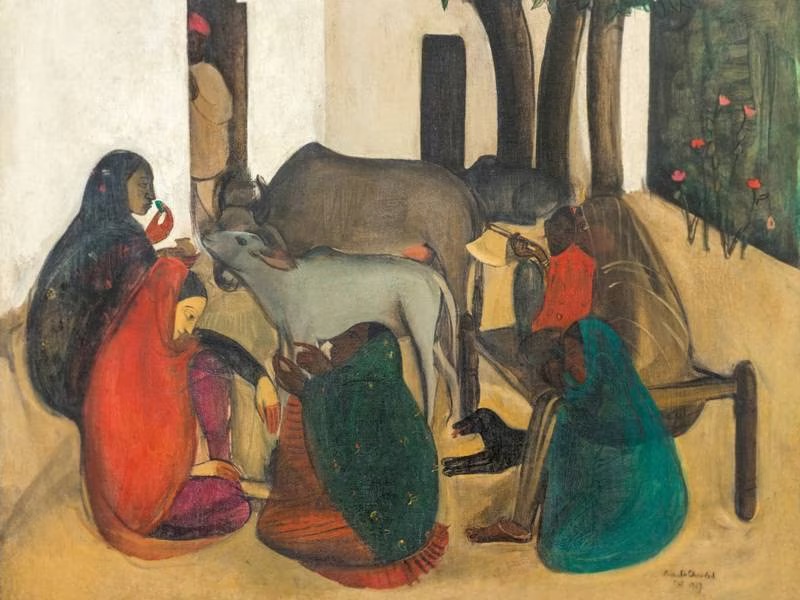Neeta Lal
This week, Indian artist Amrita Sher-Gil’s painting The Story Teller fetched a staggering $7.45 million at auction in New Delhi, becoming the most expensive piece of Indian art sold under the hammer.
Bought by an undisclosed buyer on September 16 at Saffronart auction house’s Evening Sale: Modern Art, the 23in x 29in oil on canvas was among a clutch of more than 70 pieces that also featured MF Husain, VS Gaitonde, Jamini Roy and FS Souza.
Touted to be among the 12 works selected by Sher-Gil herself as her most important, The Story Teller is widely considered one of the artist’s most honest and expressive compositions. The painting was first shown in November 1937 during her popular solo exhibition at Faletti’s Hotel in Lahore.
:quality(70)/cloudfront-eu-central-1.images.arcpublishing.com/thenational/3GUF4HTN2VCTNLRJDGWFYFA7DU.jpg)
It explores a scene from domestic life, with five women huddled together in a rural setting doing everyday tasks with cows milling around. It bears the quintessential Sher-Gil imprimatur – art spotlighting a feudal-feminine world. Sher-Gil’s other well-known portraits of women include Three Girls, Women on the Charpai, Hill Women and Young Girls.
“We are delighted to have set multiple artist records at our Evening Sale in New Delhi this September. Most significantly, the record price achieved by Amrita Sher-Gil’s The Story Teller is an important milestone in the Indian art market and a testament to the artist’s immense skill and enduring legacy as one of India’s art treasures,” said Dinesh Vazirani, chief executive of Saffronart.
Indian artist Subodh Gupta tells The National: “The Story Teller is one of Amrita Sher-Gil’s most significant works. It portrays women, a common theme in her art, reflecting her indomitable spirit and dedication to her craft which has left an indelible mark on Indian art history. This makes her a cherished national treasure, a symbol of empowerment and someone whose work ushered in profound social change.”
:quality(70)/cloudfront-eu-central-1.images.arcpublishing.com/thenational/OFRPFHSJDJEEHGZ5EYWKQSXIGM.jpg)
Sher-Gil’s previous record was for The Ladies’ Enclosure, which sold at Saffronart in July 2021 for $5.14 million, including the premium. Known as the Indian Frida Kahlo, the artist is widely acknowledged as one of the greatest avant-garde women painters of the 20th century. She melded architecture and people to portray scenes of rural domesticity through a unique artistic vocabulary.
Sher-Gil was born in 1913 in Budapest, Hungary, to a Sikh aristocrat and scholar of Sanskrit and Persian languages, Umrao Singh Sher-Gil Majithia, and a Hungarian-Jewish opera singer Marie Antoinette Gottesmann. The erudite and creative atmosphere at home shaped Sher-Gil’s personality. She became non-conformist and rebellious, and was even expelled from her convent school.
In 1929, at the age of 16, she moved to Paris to study art at the Ecole des Beaux-Arts, her work being constantly enriched by early exposure to the impressionism of Paul Cezanne and Paul Gauguin in the French capital.
Tragically, she died when she was just 28 in 1941. In 1976, the Archaeological Survey of India recognised her as one of India’s nine National Art Treasure artists, bestowing on her a special `rarity value’ internationally, meaning her works in India cannot leave the country.
:quality(70)/cloudfront-eu-central-1.images.arcpublishing.com/thenational/MZG3RHVZ2ZAB5LA7U2SNIIH3JQ.jpg)
Indian sculptor Neeraj Gupta calls Sher-Gil one of the greatest avant-garde artists of the early 20th century. “Her work defied time and society as reflected in her early portraits and nudes that are still considered among the best in contemporary Europe. This is reflected in The Story Teller as well which is an honest and empathetic portrayal much like the artist herself,” he says.
As a pathbreaker and a trailblazer, Gupta adds, Sher-Gil altered the narrative of Indian art, her feminism being a remarkable trait to have in the 1930s when women were a neglected demographic, typically relegated to the background in all social settings. “Sher-Gil chose to put her women front and centre, deliberately showing them engaged in domestic chores to reinforce that such work needs to be celebrated and not derided,” explains multimedia artist Subodh Gupta.
Gupta says Sher-Gil’s prolificity reflects her commitment to art. “Everything about her work was unique, be it her use of colour, pigment, the subjects she chose or her treatment of them. And despite the commonality of her subject matter, her artwork provides a strong visual impact, and evokes deep emotional responses, making one want to view her pieces again and again, the hallmark of a great artist.”
:quality(70)/cloudfront-eu-central-1.images.arcpublishing.com/thenational/F523Z633RBH35LEMDUMP55443Y.jpg)
Gupta adds that Sher-Gil kickstarted the movement that insisted that women mattered and were worthy muses for artists. “It takes rare courage to do this in a patriarchal era characterised by deeply entrenched mindsets, a quality that defined her and made her such a great artist.”
Over a short career of a decade, Sher-Gil was produced about 200 paintings, her early works mostly dwelling upon vibrant illustrations of Hungarian fairytales in watercolour and the later ones about domestic life in India. “I can only paint in India. Europe belongs to Picasso, Matisse, Braque … India belongs only to me,“ Sher-Gil famously declared.
Even so, her work reflects strong international influences, including that of Paul Gauguin, a controversial French artist who produced Tahitian nudes and paintings. Sher-Gil was also heavily influenced by French and Turkish elements, as also Indian painter Raja Ravi Varma whose influence is unmistakable in some of her later works.
According to Sunny Chandiramani, senior vice president of client relations at AstaGuru Auction House, Sher-Gil’s significance in the history of Indian art is profound and enduring. “Her legacy transcends mere artistic prowess; it is a testament to her role as a trailblazer and an icon of inspiration for women in the field of art. Through her remarkable fusion of western techniques and Indian subjects, her works had a universal appeal bridging the gap between traditional and modern art.”
Courtesy: thenationalnews







